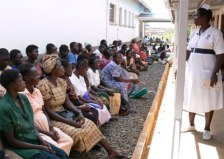In September 2011, there was a cholera epidemic across several States in Northern Nigeria, notably Yobe and Borno States. The Federal and State health Ministries were certainly overwhelmed and ill-equipped to handle the challenge. Repeated outbreaks of preventable diseases are not uncommon. http://allafrica.com/stories/201110040512.html
The Centers for Disease control and prevention (CDC) describe cholera as a disease caused by the bacteria vibrio cholerae, rare in industrialized nations, yet on the increase in many other places including Africa. It is a life threatening disease but easily preventable. http://www.cdc.gov/cholera/index.html
As a nation, Nigeria pledged to fulfill the indices of the MDGs. The fourth index of the MDG elaborated in the child survival strategies lists health education as its component.
Locally, the Ministry of health also developed the National health promotion policy. http://uspace.shef.ac.uk/servlet/JiveServlet/previewBody/13657-102-1-28049/FMOH_Health_Promotion_Policy.pdf
Following the cholera outbreak of September 2011, an informal health education session in the pediatric clinic at the Umaru Shehu Ultramodern Hospital (Maiduguri, Nigeria) with focus on hygiene was undertaken by a corps’ Doctor. The women listened with rapt attention, often accompanied by incredible nods, as they were told the benefits and impacts of hand washing in curtailing the disease. It was an unfamiliar message.
The Nation’s leaders, health team and key affiliates must recognize the crucial role of health education in general public health. The maintenance of a healthy status begins with prevention and not clinical treatment. The advantages of disease prevention and consequent reduction in morbidity and mortality cannot be over-emphasized.
Tags: CDC, Centers for Disease Control and Prevention, cholera, Haiti, National health promotion policy, nigeria, Northern Nigeria, United Nation, Yale Law School, Yale School of Public Health

August 21, 2013 at 3:48 pm |
I concur with your assessment entirely! The key in low income countries for many health related problems is always felt to be more medication, condoms, vaccines or food supplementation. However, in a resource poor setting (and those that are not as well) there occurs a cycle of poverty, food insecurity and disease. The most cost effective way to get long term solutions is frequently through health education, which is also one of the least expensive.
HIV is the classic example in these settings. If health education was adequately implemented, we would not see the continued high rates of transmission. Granted, you can now treat to prevent, but that is not cost effective. The level of health literacy for HIV remains shockingly low in most of sub Saharan Africa. Despite massive educational campaigns, there is still a tremendous amount of misinformation and persisting cultural practices that are contributing to the problem.
The key is not more ARVs, although this will help in the short term. In the long term there needs to be more complete development of health education at the community and peer levels to improve literacy and change behaviors that are putting people at risk.
October 1, 2013 at 5:58 am |
[…] guest blog is re-posted from the course blog for Social and Behavioral Foundations of Primary Health Care. The […]